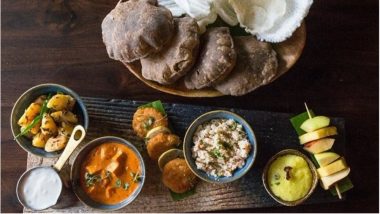Sharad Navaratri is just around the corner and it’s time for some good old Indian style festivities. And no festival in India is complete without the customary feasting. Even during Navratri, food takes centre stage. Delicacies like sabudana khichdi, kuttu ke puri and kheer are some of the lip-smacking foods served during Navratri. But there’s one difference between Navratri delicacies and foods served during the rest of the year. The former is prepared keeping, Sattvic principles in mind. In other words, Navratri foods are meant for fasting. Apart from eschewing nonvegetarian food, alcohol, Sattvic diet also requires you to stay away from certain grains, vegetables, onions, garlic and spices. But why is the Sattvic way of life so crucial during Navratri? Here’s why.
In Ayurveda, foods are classified into three types: Sattvic, Rajasic and Tamasik according to their inherent qualities. The names are derived from the Sanskrit words Sattva, Rajas and Tamas meaning pure, dynamic or royal and inert respectively. The qualities are also applicable to the food we eat. Rajasic foods are oily, rich, spicy, salty and sour in nature. These foods are also meat based. Tamasic, on the other hand, is considered unhealthy, which includes anything fermented, meat, alcohol, stale/leftover foods, overripe foods, etc. From Sabudana Khichdi to Kheer, Cook These Dishes This Navaratri.
Rajasic foods represent the dynamic energy, and it offers some benefits to the one who consumes it. Tamasic, however, is unhealthy and dull, and has no health benefits whatsoever. But the best among these is Sattvic, which represents purity and is good for a person’s overall mental, physical and spiritual health. That’s why it is recommended during the fasting season. Navratri 2018 Recipes Without Onion & Garlic: Here's What All Satvik Food You Can Cook This Navaratri.
Sattvic diet is predominantly vegetarian, although nonvegetarian food can also come under the Sattvic category. These foods are easy on the digestive system, and are low on fat and proteins. They are made with minimal spice and flavourings. During Navratri vrat or fasting, preparations are made of Sattvic “grains” such as sabudana or sago, kuttu or buckwheat, rajgira or amaranth, etc. These preparations can be turned savoury or sweet as per your liking. List of Colour-Wise Food Dishes for Each Day of the Nine-Day Navratri Festival.
Benefits of a Sattvic diet are manifold. Ancient sages had reasons to believe that these foods promoted a calm and tranquil state of mind required for spiritual pursuits. It promotes physical strength, eliminates fatigue, cures certain health problems and can even promote weight loss.
(The above story first appeared on LatestLY on Oct 09, 2018 11:13 AM IST. For more news and updates on politics, world, sports, entertainment and lifestyle, log on to our website latestly.com).













 Quickly
Quickly




















